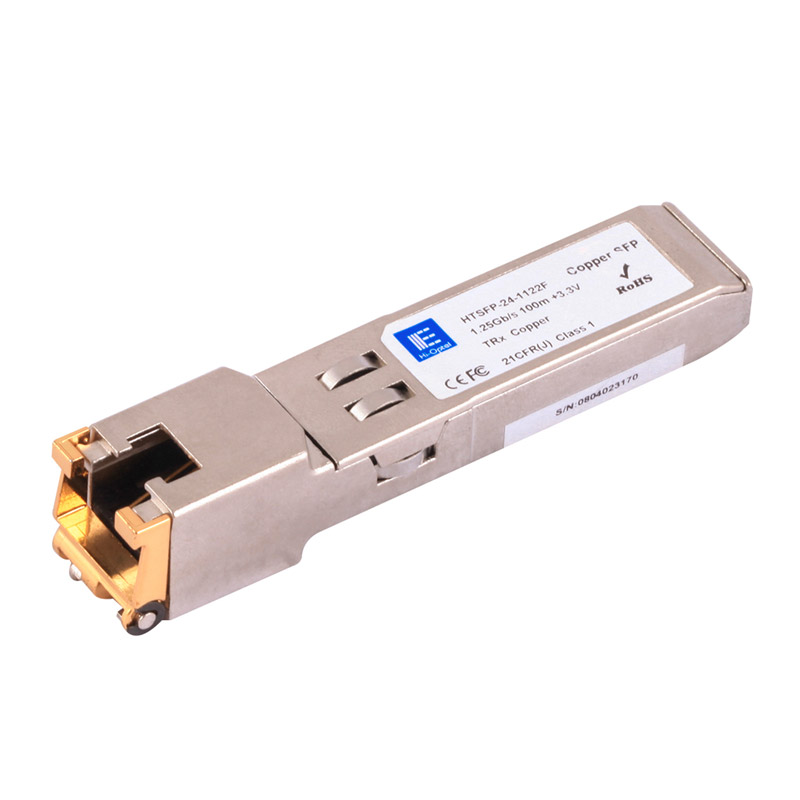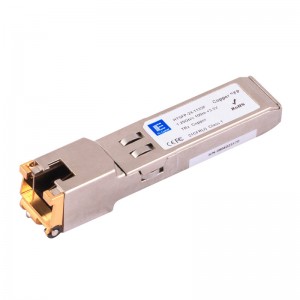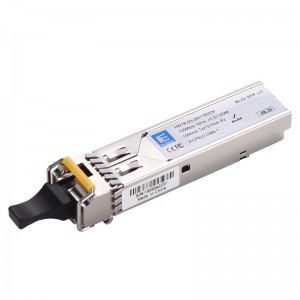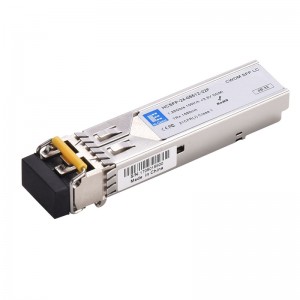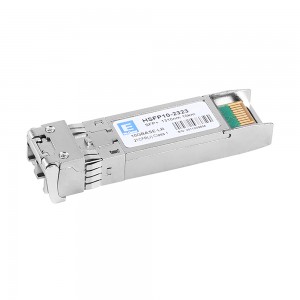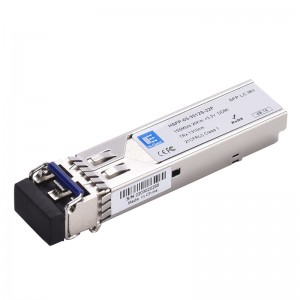1000BASE-T SFP Copper RJ-45 100m Hi-Optel HTSFP-24-1122F module
Descriptions
HTSFP-24-11x1xF is the 10/100/1000Base-T Copper SFP Transceiver.
HTSFP-24-11x2xF is the 1000Base-T only Copper SFP Transceiver.
The HTSFP - 24 - 11xxxF supports1000 Mb/s full duplex data-links with 5-level Pulse Amplitude Modulation (PAM) signals. All four pairs in the cable are used with symbol rate at 250Mb/s on each pair.
The HTSFP- 24 - 11xxxF provides standard serial ID information compliant with SFP MSA, which can be accessed with address of A0h via the 2-wire serial CMOS EEPROM protocol. The physical IC can also be accessed via 2-wire serial bus at address ACh. The address of the PHY is 1010110x,where x is the R/W bit.
Features
● Hot-pluggable SFP Footprint
● Fully Metallic Enclosure for Low EMI
● Low Power Dissipation
● Compact RJ-45 Connector Assembly
● Detailed Product Information in EEPROM
● +3.3V Single Power Supply
● Access to Physical Layer IC via 2-wire Serial Bus
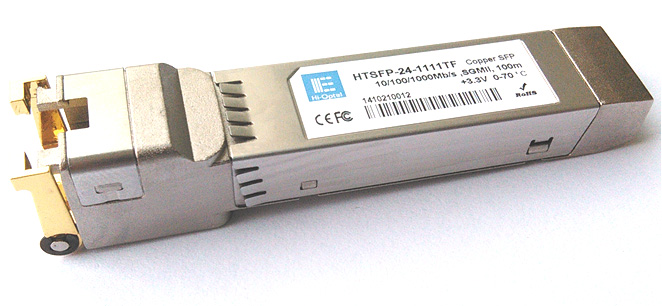
● 10/100/1000 BASE-T Operation in Host Systems with SGMII Interface
● Compliant with SFP MSA
● Compliant with IEEE Std 802.3TM-2002
● Compliant with FCC 47 CFR Part 15, Class B
● Compliant with RoHs
● Temperature range 0°C to +70°C or -40°C to +85°C
Applications
● 1.25 Gigabit Ethernet over Category 5 Cable
● Switch/Route to Switch/Route Link
● High Speed I/O for File Servers
Specification
3.1 SFP to Host Connector Pin Out
|
Pin |
Signal Name |
Description |
MSA Note |
|
1 |
VEET |
Transmitter ground (common with receiver ground) |
|
|
2 |
TFAULT |
Transmitter Fault. Not supported,Grounded in module |
Note 1 |
|
3 |
TDIS |
Transmitter Disable - Module disables on high or open |
Note 2 |
|
4 |
MOD_DEF(2) |
Module Definition 2. Data line for Serial ID. |
Note 3 |
|
5 |
MOD_DEF(1) |
Module Definition 1. Clock line for Serial ID. |
Note 3 |
|
6 |
MOD_DEF(0) |
Module Definition 0. Grounded in module. |
Note 3 |
|
7 |
Rate Select |
No connection |
|
|
8 |
LOS |
Loss of Signal - High Indicates Loss of Signal |
Note 4 |
|
9 |
VEER |
Receiver Ground (common with transmitter ground) |
|
|
10 |
VEER |
Receiver Ground (common with transmitter ground) |
|
|
11 |
VEER |
Receiver Ground(common with transmitter ground) |
|
|
12 |
RD- |
Receiver Inverted DATA out. AC Coupled |
Note 5 |
|
13 |
RD+ |
Receiver Non-inverted DATA out. AC Coupled |
Note 5 |
|
14 |
VEER |
Receiver Ground (common with transmitter ground) |
|
|
15 |
VCCR |
Receiver Power Supply |
Note 6 |
|
16 |
VCCT |
Transmitter Power Supply |
Note 6 |
|
17 |
VEET |
Transmitter Ground (Common with Receiver Ground) |
|
|
18 |
TD+ |
Transmitter Non-Inverted DATA in. AC Coupled. |
Note 7 |
|
19 |
TD- |
Transmitter Inverted DATA in. AC Coupled. |
Note 7 |
|
20 |
VEET |
Transmitter Ground(common with receiver ground) |
Notes:
1. TX Fault is not used and is always tied to ground.
2. TX Disable as described in the MSA is not applicable to the 1000BASE-T module, but is used for convenience as an input to reset the internal ASIC. This pin is pulled up within the module with a 4.7 Kohm resistor.
Low (0–0.8 V): Transceiver on
Between (0.8 V and 2.0 V): Undefined
High (2.0–3.465 V): Transceiver in reset disable state
Open: Transceiver in reset disable state
3. Mod-Def 0, 1, 2. These are the module definition pins. They should be pulled up with a 4.7-10 Kohm resistor on the host board to a supply less than VCCT + 0.3 V or VCCR + 0.3 V.
Mod Def 0 is tied to ground to indicate that the module is present.
Mod-Def 1 is clock line of two wire serial interface for optional serial ID
Mod-Def 2 is data line of two wire serial interface for optional serial ID
4. This pin is open drain CMOS output signals,They should be pulled up with a 4.7-10 Kohm resistor on the host board to a supply less than VCCT + 0.3 V or VCCR + 0.3 V. (see Table 3. Low-Speed Signals, Electronic Characteristics)
5. RD-/+: These are the differential receiver outputs. They are ac coupled 100 ohm differential lines which should be terminated with 100 ohm differential at the user SerDes. The ac coupling is done inside the module and is thus not required on the host board. The voltage swing on these lines will be between 370 and 2000 mV differential (185 – 1000 mV single ended) when properly terminated. These levels are compatible with CML and LVPECL voltage swings.
6. VCCR and VCCT are the receiver and transmitter power supplies. They are defined as 3.3 V ± 5% at the SFP connector pin. The maximum supply current is about 300mA and the associated in-rush current will typically be no more than 30 mA above steady state after 500 nanoseconds.
7. TD-/+: These are the differential transmitter inputs. They are ac coupled differential lines with 100 ohm differential termination inside the module. The ac coupling is done inside the module and is thus not required on the host board. The inputs will accept differential swings of 500 – 2400 mV (250 –1200 mV single ended), though it is recommended that values between 500 and 1200 mV differential (250 – 600 mV single ended) be used for best EMI performance. These levels are compatible with CML and LVPECL voltage swings.


